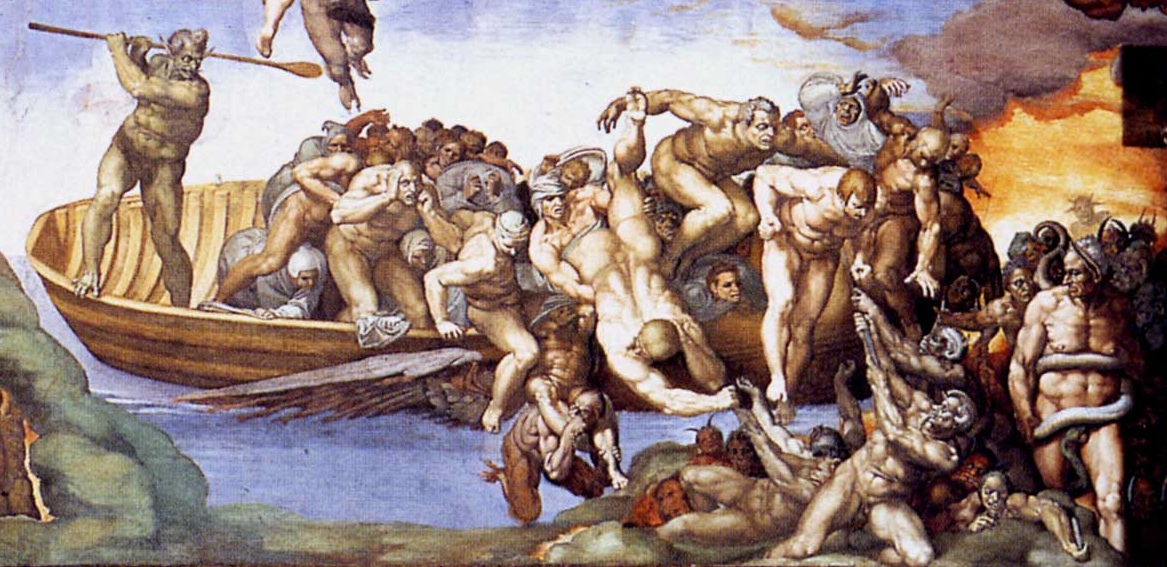Earlier this year I saw the exhibition Tales from the City by celebrated artists Wendy Sharpe and Bernard Ollis at the Orange Regional Gallery. My sister was minding the kids so I was in a hurry, but one of the last paintings I looked at, a small gouache on paper, did what a good piece of art will often do. It undid me.
In her Self Portrait and the Last Judgment Wendy Sharpe places herself in front of Michelangelo’s massive Last Judgment, but Sharpe’s rendition focuses only on the lower half of that famous piece, where the twisted, naked and humiliated figures of the damned are condemned to the flames of hell. It is in front of these figures that Sharpe paints and perhaps associates herself, looking away from the viewer, laying herself bare with a look of self loathing and self condemnation. Most of us feel this way sometimes. The failures and flaws obvious to ourselves, and often to others, the source of our shame.
 It spoke quietly and powerfully about what we like to label ‘the human condition’. It’s a brave and honest piece devoid of pretention and a million miles away from Sharpe’s self-portrait that won her the Archibald ten years ago.
It spoke quietly and powerfully about what we like to label ‘the human condition’. It’s a brave and honest piece devoid of pretention and a million miles away from Sharpe’s self-portrait that won her the Archibald ten years ago.
It reminded me of the ancient poetry contained within the early chapters of the book of Genesis, the first book in the Hebrew Bible, whose author’s intention is surely one of history’s most misunderstood. Never attempting to write a science textbook, he (some think Moses) also spoke of the human condition; exploring the source of this naked shame.
Genesis is the poetry of tragedy; a tragedy that starts full of hope in Paradise where a man and woman are “both naked and they felt no shame”. It’s a picture of humanity in all its wholeness, enjoying the intimacy of being fully known and with nothing to hide. Two people who have no concept of judgement – neither from their own selves, from each other, or from God.
But like all tragedies, things go wrong. Asserting themselves as Gods there is blame and recrimination. Perfection shattered. Realising they are naked, they sew fig leaves together to cover themselves from the gaze of the other who will see too much. When God comes walking by, they feel the need to hide among the trees. And then there’s the scene where God, stricken, stitches clothes of skin to cover them, to restore some kind of dignity and to spare them the humiliation of permanent exposure.
The writer of Genesis may not be big on the specifics of how we came to get here. Instead he paints us as broken and flawed people who need to cover up. People who are tortured by our longing for perfection.
We have different ways of dealing with our humanity. Some get sick of the cover up. With raw and sometimes embarrassing honesty they open themselves up, defying the gaze of the other, longing for the days of being ‘not ashamed’. And some go in the opposite direction. They hide behind layers that do more than just restore some dignity. The suits and stilettos, Botox and boob jobs are an attempt to reclaim perfection, to assert that we have no flaws (or not as many as others obviously have). Some of the best cover-up jobs are by the very religious, with their image of perfection and associated niceness. And some of us not sophisticated enough to hide well are exposed and condemned by some, but embraced by others.
Arundahti Roy, writer of that most beautiful and political of novels The God of Small Things is right when she speaks of the power of art. “It is the writers”, she says, ‘the poets, the singers, the filmmakers who can make the connections…who can translate cash-flow charts and scintillating board room speeches into real stories about real people with real lives”.1
A piece of art circa 2009. An ancient Scripture written 3000 years ago. Voices that help us honestly reflect on what it means to be us.
Bronwen Hanna is a Fellow of the Centre for Public Christianity
This article first appeared at ABC Religion and Ethics
[1] Roy, Arundhati the algebra of infinite justice, Flamingo 2002, 191


